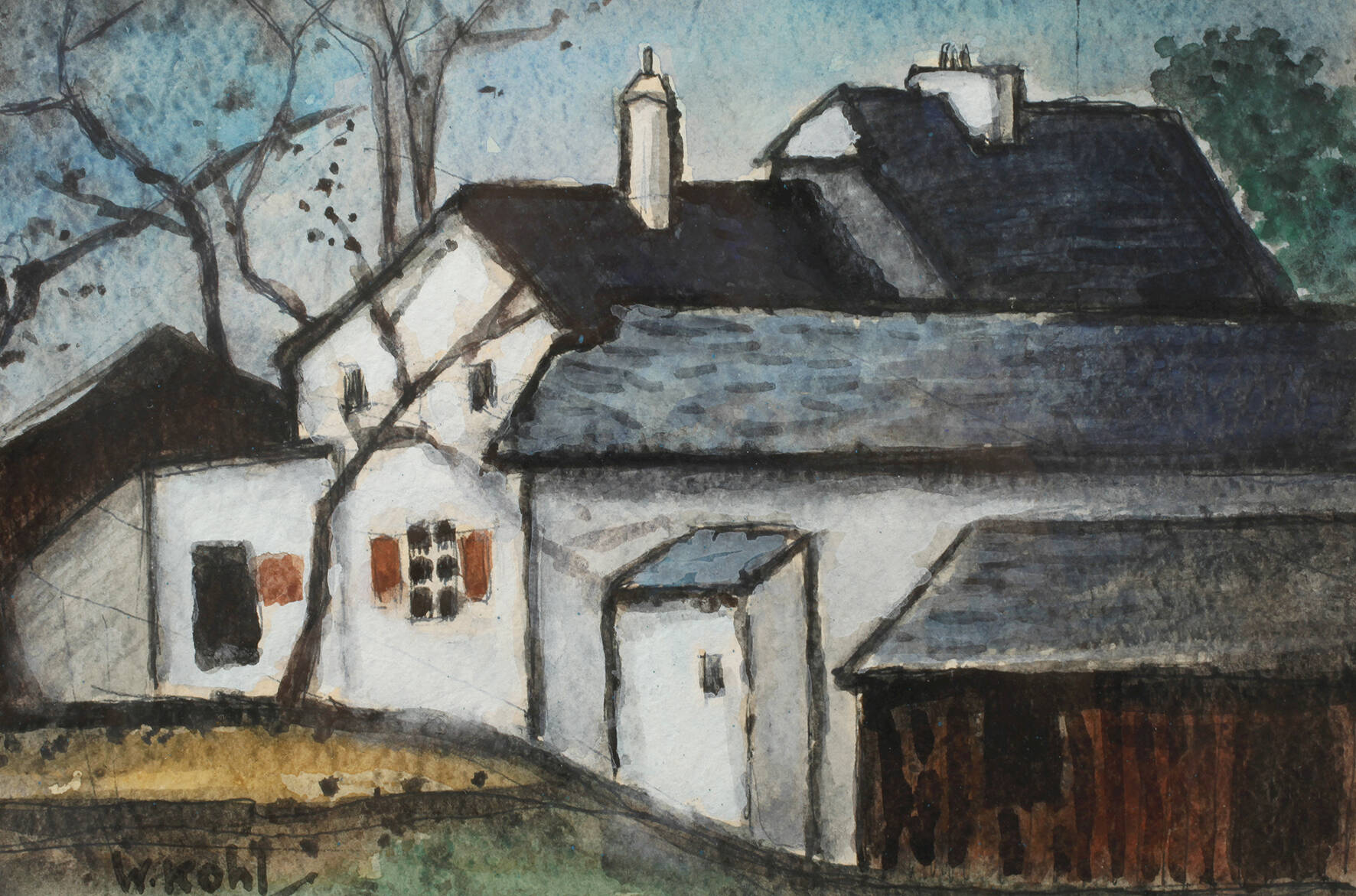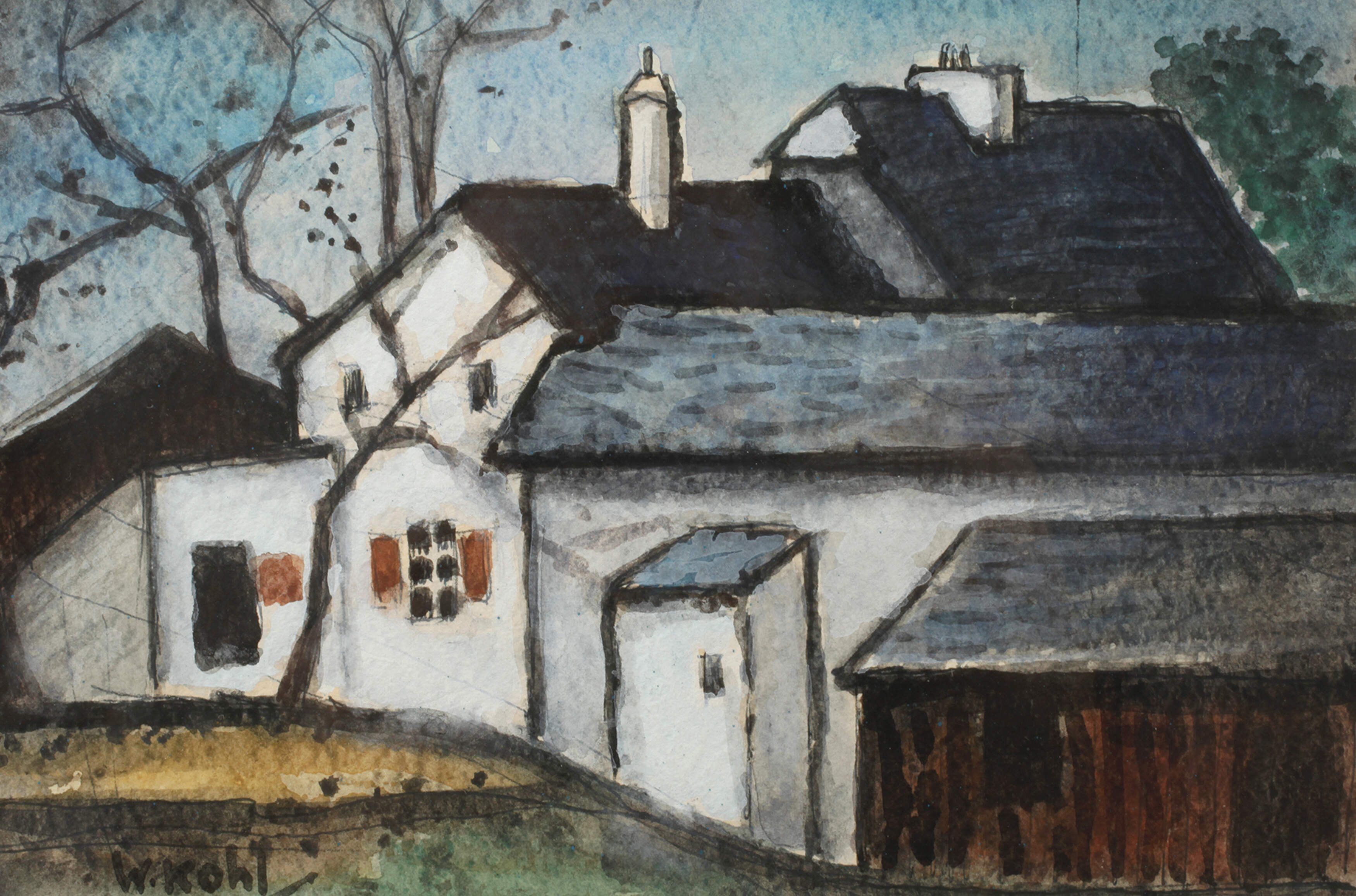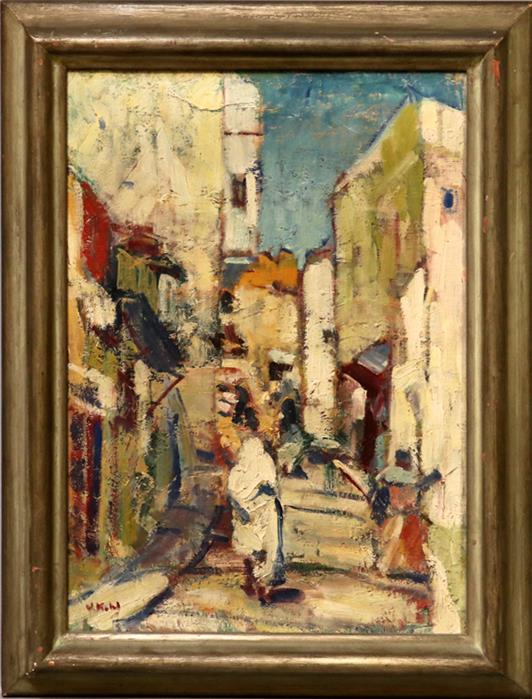WILLI KOHL* (Aachen 1888 - 1971 Aachen) Lot und seine Töchter, 1919 Öl/Leinwand, 120 x 112 cm signiert W. Kohl und datiert 19 abgebildet in Expressiver Realismus in Deutschland, Wien 2017, S. 21 Provenienz: Privatsammlung Deutschland, Galerie Elisengarten Aachen, Kunsthandel Widder SCHÄTZPREIS: °€ 15.000 - 25.000 Deutscher Maler des 20. Jahrhunderts. Besuchte die Aachener Kunstgewerbeschule und studierte an der Akademie in München und Stuttgart. Ab 1926 in Berlin, arbeitete als Grafiker v.a. als Atelierleiter des Berliner Tagesblattes. Mitglied im Verein der Berlinder Künste und der Münchner Secession. 1928 Rückkehr nach Aachen, Leiter der Klasse für Gebrauchsgrafik an der Werkkunstschule. Gründete gemeinsam mit dem Mundartdichter und Zeitungswissenschaftler Will Hermanns, dem Bildhauer Alfred Pieper, dem Dekorateur Hein Lentzen und dem Ingenieur Joseph Lausberg die Aachener Marionettenspiele. Schuf Landschaften, Stillleben und Stadtansichten, aber auch biblische Szenen wie die Szene aus dem Alten Testament. Stammt aus dem Buch Genesis, Lot und seine Töchter fliehen aus Sodom und Gomorra. Der in Aachen gebürtige Schüler der dortigen Kunstgewerbeschule und Student der Kunstakademien in München und Stuttgart Willi Kohl setzt sich hier mit einer der bekanntesten Episoden aus dem Buch Genesis des Alten Testaments auseinander. Dem Untergang von Sodom und Gomorrha. Unmittelbar vor dieser Katastrophe wurde Lot von zwei Gottesboten befohlen, mit seiner Familie die Stadt rasch zu verlassen, „ohne hinter sich zu blicken." Weil aber Lot vorerst zauderte, brachten ihn die Gottesboten samt seiner Frau und den beiden Töchtern in Sicherheit. Sie sollten sich zwar ins Gebirge zurückziehen, doch Lot wollte dies nicht und fragte daher seine Begleiter, ob sie stattdessen in der Stadt Zoar Zuflucht suchen dürften, was Lot nun auch erlaubt wurde. Bei Sonnenaufgang ließ der Herr auf Sodom und Gomorrha Schwefel und Feuer vom Himmel herabregnen. Weil sich aber Lots Frau entgegen der Weisung der Engel umdrehte, erstarrte sie zur Salzsäule, womit nur Lot und seine Töchter im Zuge dieser Rettungsaktion am Leben bleiben sollten. Kohl komprimiert die entscheidenden Momente dieser Parabel über die Verderbtheit der Menschen, das Zorngericht Gottes und dessen schützende Hand über die Gottesfürchtigen in einer Simultandarstellung. Im düsteren Vordergrund flüchtet Lot mit seinen beiden Töchtern aus der Stadt, die bereits im Feuer und Schwefel versinkt. Trotz Stilisierung in den Details und der Zeichnung der Figuren beschreibt der Maler das Zu- und Nebeneinander der Gestalten. Lots Töchter haben ihr nötigstes Hab und Gut geschultert und flankieren ihren Vater. Dieser stützt sich mit seiner Rechten auf einen Gehstock, während er mit seiner linken Hand auf seine Stirn greift. Damit bringt er wohl sein Unverständnis für seine Frau zum Ausdruck, die sich von der Gruppe löste, um dabei einen Blick auf die brennende Stadt zu werfen. Im Mittelgrund links ist eben Lots Frau, die ihre Neugierde nicht zu bezähmen wusste und die göttliche Weisung negierte, zur Salzsäule erstarrt. Berücksichtigt man den Zeitpunkt der Entstehung dieses Gemäldes, das Jahr 1919 als erstes Friedensjahr nach dem Ende des Ersten Weltkriegs, der das alte Europa in Trümmer stürzte und ob der notwendigen Aufbauarbeit keinen verklärten Blick zurück in alte Zeiten erlaubte, dann schwingt hier vielleicht auch eine zweite Bedeutungsebene mit. Kohl arbeitet in dieser Komposition mit prismatischen und rhythmischen Formen und setzt auf motivische Wiederholungen sowie auf eine kubistisch grundierte Abstraktion. Die Hauptgruppe im Vordergrund, die sich im schattenwerfenden Gleichschritt vor dem Inferno über der gottlosen Stadt in Sicherheit bringt, postiert Kohl vor einer im Feuerschein hell erleuchteten Landschaft, deren Abstraktionsgrad in Richtung Hintergrund noch gesteigert scheint. Man könnte fast von einem Bruch sprechen, der sich hier in der Wahl der Abstraktionsmittel bei der Vorder- und Hintergrund
WILLI KOHL* (Aachen 1888 - 1971 Aachen) Lot and his Daughters, 1919 oil/canvas, 120 x 112 cm signed W. Kohl and dated 19 depicted in Expressiver Realismus in Deutschland, Vienna 2017, S. 21 Provenance: private collection Germany, Gallery Elisengarten Aachen (Germany), Fine Arts Widder ESTIMATE °€ 15.000 - 25.000 German painter of the 20th century. Attended the Aachen School of Arts and Crafts and studied at the Academy in Munich and Stuttgart. From 1926 in Berlin, worked as a graphic artist mainly as studio manager of the Berliner Tagesblatt. Member of the Verein der Berlinder Künste and the Munich Secession. 1928 Returned to Aachen, head of the class for commercial art at the Werkkunstschule. Together with the dialect poet and newspaper scholar Will Hermanns, the sculptor Alfred Pieper, the decorator Hein Lentzen and the engineer Joseph Lausberg, founded the Aachen Marionette Plays. Created landscapes, still lifes and cityscapes, but also biblical scenes such as the scene from the Old Testament. Taken from the Book of Genesis, Lot and his daughters flee from Sodom and Gomorrah. Aachen-born student of the local School of Applied Arts and student of the art academies in Munich and Stuttgart Willi Kohl deals here with one of the most famous episodes from the Book of Genesis of the Old Testament. The fall of Sodom and Gomorrah. Immediately before this catastrophe, Lot was commanded by two messengers of God to leave the city quickly with his family, "without looking behind him." But because Lot hesitated for the time being, the messengers of God brought him to safety along with his wife and two daughters. They were told to retreat to the mountains, but Lot did not want to do so, so he asked his companions if they could seek refuge in the city of Zoar instead, which Lot was now allowed to do. At sunrise, the Lord rained down sulfur and fire from heaven on Sodom and Gomorrah. But because Lot's wife turned around against the instruction of the angels, she froze to a pillar of salt, with which only Lot and his daughters should remain alive in the course of this rescue action. Kohl compresses the decisive moments of this parable about the depravity of mankind, the wrath of God and his protective hand over the God-fearing in a simultaneous depiction. In the somber foreground Lot flees with his two daughters from the city, which is already sinking in fire and brimstone. Despite stylization in the details and the drawing of the figures, the painter describes the togetherness and juxtaposition of the figures. Lot's daughters have shouldered their most necessary belongings and flank their father. The father is leaning with his right hand on a walking stick, while he grasps his forehead with his left hand. With it he expresses probably his incomprehension for his wife, who separated from the group, in order to throw a view of the burning city. In the middle ground on the left Lot's wife, who did not know how to restrain her curiosity and negated the divine instruction, has frozen to a pillar of salt. If one takes into account the time when this painting was created, the year 1919 as the first year of peace after the end of the First World War, which plunged the old Europe into ruins and, because of the necessary reconstruction work, did not allow a glorified look back to the old times, then perhaps a second level of meaning resonates here. In this composition, Kohl works with prismatic and rhythmic forms and relies on motivic repetition as well as on a cubist-based abstraction. Kohl positions the main group in the foreground, which is moving in shadowy unison to safety from the inferno over the godless city, in front of a landscape brightly illuminated in the firelight, whose degree of abstraction seems to be heightened even further in the direction of the background. One could almost speak of a rupture that emerges here in the choice of means of abstraction in the foreground and background design. The spatial stage of the foreground is char
WILLI KOHL* (Aachen 1888 - 1971 Aachen) Lot und seine Töchter, 1919 Öl/Leinwand, 120 x 112 cm signiert W. Kohl und datiert 19 abgebildet in Expressiver Realismus in Deutschland, Wien 2017, S. 21 Provenienz: Privatsammlung Deutschland, Galerie Elisengarten Aachen, Kunsthandel Widder SCHÄTZPREIS: °€ 15.000 - 25.000 Deutscher Maler des 20. Jahrhunderts. Besuchte die Aachener Kunstgewerbeschule und studierte an der Akademie in München und Stuttgart. Ab 1926 in Berlin, arbeitete als Grafiker v.a. als Atelierleiter des Berliner Tagesblattes. Mitglied im Verein der Berlinder Künste und der Münchner Secession. 1928 Rückkehr nach Aachen, Leiter der Klasse für Gebrauchsgrafik an der Werkkunstschule. Gründete gemeinsam mit dem Mundartdichter und Zeitungswissenschaftler Will Hermanns, dem Bildhauer Alfred Pieper, dem Dekorateur Hein Lentzen und dem Ingenieur Joseph Lausberg die Aachener Marionettenspiele. Schuf Landschaften, Stillleben und Stadtansichten, aber auch biblische Szenen wie die Szene aus dem Alten Testament. Stammt aus dem Buch Genesis, Lot und seine Töchter fliehen aus Sodom und Gomorra. Der in Aachen gebürtige Schüler der dortigen Kunstgewerbeschule und Student der Kunstakademien in München und Stuttgart Willi Kohl setzt sich hier mit einer der bekanntesten Episoden aus dem Buch Genesis des Alten Testaments auseinander. Dem Untergang von Sodom und Gomorrha. Unmittelbar vor dieser Katastrophe wurde Lot von zwei Gottesboten befohlen, mit seiner Familie die Stadt rasch zu verlassen, „ohne hinter sich zu blicken." Weil aber Lot vorerst zauderte, brachten ihn die Gottesboten samt seiner Frau und den beiden Töchtern in Sicherheit. Sie sollten sich zwar ins Gebirge zurückziehen, doch Lot wollte dies nicht und fragte daher seine Begleiter, ob sie stattdessen in der Stadt Zoar Zuflucht suchen dürften, was Lot nun auch erlaubt wurde. Bei Sonnenaufgang ließ der Herr auf Sodom und Gomorrha Schwefel und Feuer vom Himmel herabregnen. Weil sich aber Lots Frau entgegen der Weisung der Engel umdrehte, erstarrte sie zur Salzsäule, womit nur Lot und seine Töchter im Zuge dieser Rettungsaktion am Leben bleiben sollten. Kohl komprimiert die entscheidenden Momente dieser Parabel über die Verderbtheit der Menschen, das Zorngericht Gottes und dessen schützende Hand über die Gottesfürchtigen in einer Simultandarstellung. Im düsteren Vordergrund flüchtet Lot mit seinen beiden Töchtern aus der Stadt, die bereits im Feuer und Schwefel versinkt. Trotz Stilisierung in den Details und der Zeichnung der Figuren beschreibt der Maler das Zu- und Nebeneinander der Gestalten. Lots Töchter haben ihr nötigstes Hab und Gut geschultert und flankieren ihren Vater. Dieser stützt sich mit seiner Rechten auf einen Gehstock, während er mit seiner linken Hand auf seine Stirn greift. Damit bringt er wohl sein Unverständnis für seine Frau zum Ausdruck, die sich von der Gruppe löste, um dabei einen Blick auf die brennende Stadt zu werfen. Im Mittelgrund links ist eben Lots Frau, die ihre Neugierde nicht zu bezähmen wusste und die göttliche Weisung negierte, zur Salzsäule erstarrt. Berücksichtigt man den Zeitpunkt der Entstehung dieses Gemäldes, das Jahr 1919 als erstes Friedensjahr nach dem Ende des Ersten Weltkriegs, der das alte Europa in Trümmer stürzte und ob der notwendigen Aufbauarbeit keinen verklärten Blick zurück in alte Zeiten erlaubte, dann schwingt hier vielleicht auch eine zweite Bedeutungsebene mit. Kohl arbeitet in dieser Komposition mit prismatischen und rhythmischen Formen und setzt auf motivische Wiederholungen sowie auf eine kubistisch grundierte Abstraktion. Die Hauptgruppe im Vordergrund, die sich im schattenwerfenden Gleichschritt vor dem Inferno über der gottlosen Stadt in Sicherheit bringt, postiert Kohl vor einer im Feuerschein hell erleuchteten Landschaft, deren Abstraktionsgrad in Richtung Hintergrund noch gesteigert scheint. Man könnte fast von einem Bruch sprechen, der sich hier in der Wahl der Abstraktionsmittel bei der Vorder- und Hintergrund
WILLI KOHL* (Aachen 1888 - 1971 Aachen) Lot and his Daughters, 1919 oil/canvas, 120 x 112 cm signed W. Kohl and dated 19 depicted in Expressiver Realismus in Deutschland, Vienna 2017, S. 21 Provenance: private collection Germany, Gallery Elisengarten Aachen (Germany), Fine Arts Widder ESTIMATE °€ 15.000 - 25.000 German painter of the 20th century. Attended the Aachen School of Arts and Crafts and studied at the Academy in Munich and Stuttgart. From 1926 in Berlin, worked as a graphic artist mainly as studio manager of the Berliner Tagesblatt. Member of the Verein der Berlinder Künste and the Munich Secession. 1928 Returned to Aachen, head of the class for commercial art at the Werkkunstschule. Together with the dialect poet and newspaper scholar Will Hermanns, the sculptor Alfred Pieper, the decorator Hein Lentzen and the engineer Joseph Lausberg, founded the Aachen Marionette Plays. Created landscapes, still lifes and cityscapes, but also biblical scenes such as the scene from the Old Testament. Taken from the Book of Genesis, Lot and his daughters flee from Sodom and Gomorrah. Aachen-born student of the local School of Applied Arts and student of the art academies in Munich and Stuttgart Willi Kohl deals here with one of the most famous episodes from the Book of Genesis of the Old Testament. The fall of Sodom and Gomorrah. Immediately before this catastrophe, Lot was commanded by two messengers of God to leave the city quickly with his family, "without looking behind him." But because Lot hesitated for the time being, the messengers of God brought him to safety along with his wife and two daughters. They were told to retreat to the mountains, but Lot did not want to do so, so he asked his companions if they could seek refuge in the city of Zoar instead, which Lot was now allowed to do. At sunrise, the Lord rained down sulfur and fire from heaven on Sodom and Gomorrah. But because Lot's wife turned around against the instruction of the angels, she froze to a pillar of salt, with which only Lot and his daughters should remain alive in the course of this rescue action. Kohl compresses the decisive moments of this parable about the depravity of mankind, the wrath of God and his protective hand over the God-fearing in a simultaneous depiction. In the somber foreground Lot flees with his two daughters from the city, which is already sinking in fire and brimstone. Despite stylization in the details and the drawing of the figures, the painter describes the togetherness and juxtaposition of the figures. Lot's daughters have shouldered their most necessary belongings and flank their father. The father is leaning with his right hand on a walking stick, while he grasps his forehead with his left hand. With it he expresses probably his incomprehension for his wife, who separated from the group, in order to throw a view of the burning city. In the middle ground on the left Lot's wife, who did not know how to restrain her curiosity and negated the divine instruction, has frozen to a pillar of salt. If one takes into account the time when this painting was created, the year 1919 as the first year of peace after the end of the First World War, which plunged the old Europe into ruins and, because of the necessary reconstruction work, did not allow a glorified look back to the old times, then perhaps a second level of meaning resonates here. In this composition, Kohl works with prismatic and rhythmic forms and relies on motivic repetition as well as on a cubist-based abstraction. Kohl positions the main group in the foreground, which is moving in shadowy unison to safety from the inferno over the godless city, in front of a landscape brightly illuminated in the firelight, whose degree of abstraction seems to be heightened even further in the direction of the background. One could almost speak of a rupture that emerges here in the choice of means of abstraction in the foreground and background design. The spatial stage of the foreground is char











Try LotSearch and its premium features for 7 days - without any costs!
Be notified automatically about new items in upcoming auctions.
Create an alert